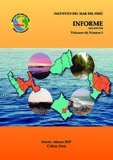Por favor, use este identificador para citar o enlazar este ítem:
https://hdl.handle.net/20.500.12958/3148Registro completo de metadatos
| Campo DC | Valor | Lengua/Idioma |
|---|---|---|
| dc.contributor.author | Quipuzcoa Olguín, Luis | - |
| dc.contributor.author | Romero Chuquival, Dennis | - |
| dc.contributor.author | Aramayo, Víctor | - |
| dc.contributor.author | Marquina Herrera, Robert | - |
| dc.contributor.author | Gutiérrez Aguilar, Dimitri | - |
| dc.date.accessioned | 2017-09-18T17:42:42Z | - |
| dc.date.available | 2017-09-18T17:42:42Z | - |
| dc.date.issued | 2017 | - |
| dc.identifier.citation | Inf Inst Mar Perú 44(1), 2017. p. 20-27 | es_ES |
| dc.identifier.uri | https://hdl.handle.net/20.500.12958/3148 | - |
| dc.description | Informe IMARPE 44(1), 2017 p. 20-27 / Programa Presupuestal 068: Reducción de vulnerabilidad y atención de emergencias por desastres | es_ES |
| dc.description.abstract | Se describe la variabilidad interanual oceanográfica y de la comunidad del macrobentos en una estación ubicada a 102 m de profundidad frente a Chicama (07°48’S) entre 2013 y 2016. Sobre el fondo, se detectaron condiciones disóxicas desde 2013 hasta marzo 2014; que fueron seguidas por un período de oxigenación hasta la primavera del mismo año, asociado al desarrollo del evento El Niño costero moderado 2014. A partir de abril 2015 se detectó un período más prolongado de oxigenación hasta el verano de 2016, asociado al Niño Costero Fuerte 2015-2016. Los episodios de oxigenación fueron ocasionados por la propagación de ondas Kelvin cálidas atrapadas en la costa. La abundancia y la biomasa del macrobentos fueron muy fluctuantes bajo las condiciones cálidas predominantes desde el invierno 2014, sin ser significativamente diferentes al período frío anterior. Sin embargo, se observó un aumento paulatino de la riqueza específica durante el período cálido, explicado en parte por la llegada de especies características de la plataforma norte del Perú. | es_ES |
| dc.description.abstract | ABSTRACT: The interannual oceanographic and community variability of the macrobenthos in a station located at a depth of 102 m in front of Chicama (07°48’S) between 2013 and 2016 is described. On the bottom, dysoxic conditions were detected from 2013 to March 2014; which was followed by a period of oxygenation until the spring of the same year, associated with the development of the moderate coastal El Niño event of 2014. As of April 2015, a longer period of oxygenation was detected until the summer of 2016, associated with the strong coastal El Niño 2015-2016. Oxygenation episodes were caused by the propagation of warm Kelvin waves trapped on the coast. The abundance and biomass of macrobenthos were very fluctuating under the prevailing warm conditions since winter 2014, without being significantly different from the previous cold period. However, there was a gradual increase of specific richness during the warm period, explained in part by the arrival of species characteristic of the northern platform of Peru. | - |
| dc.description.sponsorship | IMARPE | es_ES |
| dc.language.iso | spa | es_ES |
| dc.publisher | Callao | es_ES |
| dc.relation.ispartofseries | Informe IMARPE;vol. 44 n°1, 2017 | - |
| dc.rights | info:eu-repo/semantics/openAccess | es_ES |
| dc.rights.uri | https://creativecommons.org/licenses/by/4.0/ | - |
| dc.source | Instituto del Mar del Perú - IMARPE | es_ES |
| dc.source.uri | Repositorio Digital IMARPE | es_ES |
| dc.subject | Macrobentos | es_ES |
| dc.subject | Oceanografía | es_ES |
| dc.title | Cambios del macrobentos en una estación fija frente a Chicama y su relación con la variabilidad oceanográfica. | es_ES |
| dc.title.alternative | Macrobenthos changes in the continental shelf off Chicama related oceanographic variability | es_ES |
| dc.type | info:eu-repo/semantics/article | es_ES |
| Aparece en las colecciones: | Informe vol. 44(1), 2017 | |
Ficheros en este ítem:
| Fichero | Descripción | Tamaño | Formato | |
|---|---|---|---|---|
| Informe 44(1)-3.pdf | 2,63 MB | Adobe PDF |  Visualizar/Abrir |
Este ítem está sujeto a una licencia Creative Commons Licencia Creative Commons

